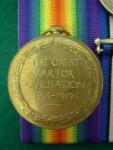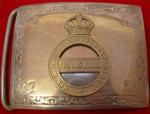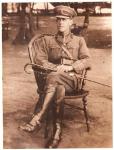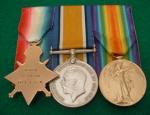
sabrigade
For Deletion-
Posts
1,707 -
Joined
-
Last visited
-
Days Won
34
Content Type
Profiles
Forums
Blogs
Gallery
Events
Store
Everything posted by sabrigade
-
http://gmic.co.uk/uploads/monthly_06_2009/post-3034-1245821433.jpghttp://gmic.co.uk/uploads/monthly_06_2009/post-3034-1245821368.jpg MEDALS TO N0 945 PRIVATE A. SHOVAL, 1ST CAPE COLOURED LABOR REGIMENT There was also a Cape Coloured Labor Regiment that was formed for service in France. Regarded as an Imperial Unit or Structure, they were awarded the normal British World War 1 campaign medals and they were issued with the British Victory and NOT the South African version. Costs were paid by the British Authorities for the medal issues.
-
Hi Chris, Very well stated. This factor was applied in many instances in the more specialised type of units or musterings. Another good example was the appointment of Lt Col F. R. Collins to command the South African Railway Companies and Miscellaneous Trades Company in France. A few days before he was a mechanical superintendent in the South African Railways! In my collection I have the medals of the RSM of the Miscellaneous Trades Company who joined up as Private and was appointed as the Regimental Sargeant Major the following day. In his favour, he was a survivor of B Battery at Maiwand in Afghanistan and was also a Boer War veteran. He ended his WW1 service with a Meritorious Service Medal. Regards, Will
-
This was a decision made by the South African governernment at the time. In a previous post where I posted a trio with the prefix "N" I referred to the amount of ill feeling that the isue of medals to memebers of the SAMR and SAA caused amonst veterans of the SANLC. Only 10% of the SANLC memebers recieved their medals and they were not South Africans. The racial and cost issue has been raised as the possible reasons for not awarding the medals to Black South African members of the SANLC.
-
A great amount of research was done by a previous collector who owned the group. In a write up he states: " On 27 June 1919 the London Gazette published Archie's award of the Commander of the British Empire for service in recruiting the SANLC " Godley was well known to both Genls Louis Botha and Jan Smuts because of the work he did and the circles both he and his family moved in.
-
My opinion, based on the fact that Officers of the SANLC were selected and appointed on their previous experience of working with so-called natives, is that this was the major factor in his appointment and his position in the SANLC. Probably there was very little difference between his military position in the SANLC and civilian appointment in the Public or Civil Service. All Battalion Commanders in the 1st South African Infantry Brigade were regular combat officers who were specifically selected to lead their battalions in battle on the Western Front. Godley's position was an administrative one and he was used to plan policies and directives for the SANLC. His brother was Major General Aleck Godley so this may have also played a part but I am not convinced that it did. He had married into the Shepstone family which was a very prominent family in the South African civil service and his father-in-law was the Chief Native Commisioner for Natal at the time so he did have an obvious amount of support during his military service and appointment.
-
THE MOST EXCELLENT ORDER OF THE BRITISH EMPIRE COMMANDER (CBE),BRITISH WAR MEDAL 1914 -20, VICTORY MEDAL Archie Godley was born on 13 October 1871. He was part of a family with strong military conditions. He attended Wellington College but had to seek employment after his father's death in 1889. He moved to Sumatra in the Dutch East Indies and worked on a coffee plantation. This was followed by a move to Siam where Archie was involved in railway construction. In 1893, Godley joined the Cape Mounted Rifles. After being discharged for being medically unfit in 1895, Godley joined the Natal Civil Service. In 1901, he became an assistant to Sir Godfrey Lagden the Commissioner for Native Affairs in the Transvaal. By 1912, Godley was the Chief Clerk in the Union Government Native Affairs Department. In September 1916, Archie was commissioned in the SANLC as a Lieutenant Colonel and he duly arrived in France in 1917. His work with the SANLC was mainly concerned with Headquarters activities. When the SANLC were disbanded, Archie was released from his military service in April 1918 and he returned to the Civil Service. He was awarded the CBE for his services in the SANLC and the decoration was gazetted on 27 June 1919.
-
BRITISH WAR MEDAL 1914-20, VICTORY MEDAL, WAR MEDAL 1939-45, AFRICA SERVICE MEDAL GROUP AWARDED TO CPL WIEGARDT FOR SERVICE IN WW1 AND WW2 White or European members of the SANLC , all officers and NCO's, were entitled to the normal British World War One campaign medals. This group is the typical example of a medal recipient to the SANLC.
-
BRONZE BRITISH WAR MEDAL 1914 - 20 This South African Native Labour Corps existed from 1916 to 1918. It was raised from the Black populations from South Africa and the High Commission Territories for service in France. The contingents spent specific periods of time in France, a year I think, and rendered very good service. Officers were often selected for their experience in working with the black population. The strength of the Corps is given as 292 Officers, 1404 European Non-Commissioned Officers and 25000 other ranks. As far as I can determine, NO medals were issued to South African black members of the Contingent and the awards were limted to members from the High Commission Territories - Swaziland, Bechuanaland (Botswana) and Basutholand (Lesotho). Figures vary but it would appear that approximately ONLY 2500 medals were awarded to the SANLC. The Bronze War Medal was also issued to Chinese, Indian and Maltese presonnel in labour batalions. A total of approximately 110000 of these medals were awarded (Medal Yearbook 2009).
-
Hi Tom, A very pertinent question. The prefix before his rank 'N" stands for Native which referred to black people in those days. Constable Van Wyk was probably a man of mixed race as the 5th SAMR was formed from the Cape Mounted Police from the then Cape Province. I also have a WW1 trio named to a gentleman with the prefix "C" which refererred to Coloured or people of mixed race. They tended to adopt Boer surnames and their home language was Afrikaans or Dutch. This practice of using prefixes to denote various racial groupings was continued in WW2 where various prefixes can be found on South African issued campaign medals. There are many questions regarding the issue of these WW1 medals and I hope to gain more insight into the matter, that is one reason why I decided to post this possibly controversial but interesting and unfortunate topic. Regards, Will























